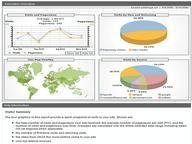Quiz Answer Key and Fun Facts
1. A duelist playing the "Yu Gi Oh" trading card game wants to win using the Exodia cards. These are a set of five different cards, each containing a piece of Exodia's body. In the game, each player draws a starting hand of five cards. Assuming the player has a deck of 40 cards which contains a complete Exodia set and where all the cards are different (i.e. contains no duplicate cards), what are the odds that their starting hand of five cards will be the complete Exodia set?
2. A gambler in a casino is playing Craps. In this game, he rolls two fair dice at the same time and adds the two faces that come up. If his first roll is a seven or eleven, he wins. If his first roll is a two, three, or twelve, he loses. If it is anything else, he keeps rolling until he gets either a seven (in which case he loses) or whatever number he rolled (in which case he wins). What are the odds the gambler will win his next game of Craps?
3. To pick a winning 4 digit lottery number, a lottery commissioner has four urns. Each urn contains ten balls. The balls in each urn are numbered zero through nine. One ball is picked out of each urn to make up one digit of the winning number. What are the odds that the winning number consists only of nines or zeros?
4. A bus is guaranteed to arrive at the bus stop between 8:00 am and 8:15 am. It is no more likely to arrive at any time than any other time in this interval (i.e. the probability density function is uniform). What is the probability that the bus will arrive at 8:05 am?
5. When flipping a fair coin, we would obviously expect to get 5 heads out of 10 tosses, but what are the odds of this actually happening?
6. An insurance company determines that the probabilities of a driver in their 20s, 30s, 40s, 50s, and 60s getting into a crash at least once within these respective decades are 0.9, 0.6, 0.5, 0.4, and 0.75 respectively. A random driver signs up for coverage on their 20th birthday. Ignoring any other factors, what are the chances that they will get into their first accident in their 60s?
7. The lifetime of a copy machine from the time of purchase is described by the probability density function f(x)=.5*e^(-.5*x). A warranty refunds the purchase price of the machine if it dies within one year after purchase. What is the probability that this warranty will be paid out for a randomly selected machine?
8. An insurance company determines that the probability of the Boston Red Sox winning the World Series to be (3/32). Jordan's Furniture is running a promotion that will allow customers to keep any furniture they purchased between March 8 and April 16 for free. To cover against potential losses, Jordan's wants to take out an insurance policy that will pay them $20,000,000 if the Red Sox win the World Series. How much should the insurance company charge for this policy to cancel out their expected payout?
9. In poker (played with a regular 52 card deck), a royal flush is when you have a ten, jack, queen, king, and ace all of the same suit. If a man is playing five card stud poker (where you are dealt five cards and can not draw more), what is the probability that he will be dealt a royal flush?
10. The probability density function of the number of seconds it takes for the eyes of a random patient involved in a study to adjust to the light in a room is f(x) = 3 * x^2 from 0 to 1. What is the probability that a randomly selected patient's eyes will adjust to a room's lighting in between (1 / 2) and (3 / 4) seconds?
Source: Author
jrrymaury
This quiz was reviewed by FunTrivia editor
crisw before going online.
Any errors found in FunTrivia content are routinely corrected through our feedback system.
